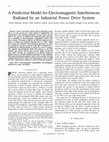Papers by Giulio Antonini
Computer Standards & Interfaces, 1999
With increasing use of switching power supplies in industrial applications and the necessity to r... more With increasing use of switching power supplies in industrial applications and the necessity to respect standards, problems of electromagnetic compatibility have to be solved. In order to reduce the number of prototypes, costs and delays, it is necessary to evaluate and to measure the characteristics of the structure. For this, a modelling process has been developed to foresee the behaviour
IEEE Transactions on Electromagnetic Compatibility, 2006
The feature selective validation (FSV) method has been proposed as a technique to allow the objec... more The feature selective validation (FSV) method has been proposed as a technique to allow the objective, quantified, comparison of data for inter alia validation of computational electromagnetics. In the companion paper "Feature selective validation for validation of computational electromagnetics. Part I-The FSV method," the method was outlined in some detail. This paper addresses two specific issues related to the implementation of the FSV method, namely "how well does it produce results that agree with visual assessment?" and "what benefit can it provide in a practical validation environment?" The first of these questions is addressed by comparing the FSV output to the results of an extensive survey of EMC engineers from several countries. The second is approached via a case study analysis.
... The paper has studied the fundamental interactions associated to the EM coupling between the ... more ... The paper has studied the fundamental interactions associated to the EM coupling between the EBG cavity and the ... 20 :,: : : jf - -1-- - - ~ 0 0 2 3 4 5 6 Frequency [GHz] (a) 120 , ... at the BG frequencies, therefore the bridge inductance along the current return path limits the return ...
IEEE Transactions on Electromagnetic Compatibility, 2006
The feature selective validation (FSV) method has been proposed as a technique to allow the objec... more The feature selective validation (FSV) method has been proposed as a technique to allow the objective, quantified, comparison of data for inter alia validation of computational electromagnetics. In the companion paper "Feature selective validation for validation of computational electromagnetics. Part I-The FSV method," the method was outlined in some detail. This paper addresses two specific issues related to the implementation of the FSV method, namely "how well does it produce results that agree with visual assessment?" and "what benefit can it provide in a practical validation environment?" The first of these questions is addressed by comparing the FSV output to the results of an extensive survey of EMC engineers from several countries. The second is approached via a case study analysis.
IEEE Transactions on Electromagnetic Compatibility, 2004
A SPICE circuit model is developed for the evaluation in frequency and time domain, of the common... more A SPICE circuit model is developed for the evaluation in frequency and time domain, of the common and differential mode voltages at the terminals of a two-parallel-wires shielded cable during a current injection test. The proposed circuit is an exact equivalent of the model's governing multiconductor transmission line equations without the need of any subdivision in elementary cells and takes into account the presence of both transfer impedance and admittance.

IEEE Transactions on Electromagnetic Compatibility, 2005
This paper considers the case of a wide-band Lorentzian (WBL) algorithm in the finite-difference ... more This paper considers the case of a wide-band Lorentzian (WBL) algorithm in the finite-difference time-domain (FDTD) modeling of dispersive media. It is shown herein that the WBL model is a physically meaningful and practically useful case of the frequency behavior of materials along with the Debye and narrow-band Lorentzian (NBL). The recursive convolution algorithms for the finite-difference time-domain technique for NBL and WBL models differ. The Debye model, which is suitable for comparatively low-frequency dispersive materials, may not have sufficient number of parameters for describing the wide-band material, especially if this material exhibits pronounced absorption at higher frequencies. It is shown that the Debye model can be used, if the -factor of the linear circuit analog corresponding to the Lorentzian model of the material is less than approximately 0.8. If the quality factor is in the limits of about 0 8 1, then the WBL model is appropriate. For 1, the NBL model must be applied. The NBL model is suitable for dielectrics exhibiting resonance effects in the microwave frequency range. The WBL model is typical for composites filled with conducting fibers. Index Terms-Debye model, dispersive media, finite-difference time-domain (FDTD) technique, Lorentzian model, recursive convolution.
IEEE Transactions on Microwave Theory and Techniques, 2000
This paper extends the use of a neural network (NN) approximating a function, to the evaluation o... more This paper extends the use of a neural network (NN) approximating a function, to the evaluation of the gradient of the same function. This is done without any extra training of the network. The evaluation of the function's gradient is used in NN-based optimization procedures in order to speed up the convergence and to maintain the overall accuracy. Index Terms-Modeling, neural network, optimization methods.
The partial element equivalent circuit (PEEC) method has been applied for the time and frequency ... more The partial element equivalent circuit (PEEC) method has been applied for the time and frequency domain modeling of many different EMI problems. This method is especially suitable for the solution of problems which involve mixed circuit and electromagnetic parts as they occur in a VLSI system. An important issue for all modeling techniques is the faster solution of larger problems of this type. The makes the solution of more realistic EMC problems possible. We explore the application of the wavelet transform to the PEEC circuit matrix in both the time and the frequency domains. Further, examples are given for the speed-up due to the wavelet transform for both domains
The feature selective validation (FSV) method is one of the candidate techniques for the quantita... more The feature selective validation (FSV) method is one of the candidate techniques for the quantitative validation of computational electromagnetics (CEM), particularly within electromagnetic compatibility (EMC) and signal integrity (SI). In applications so far, it has demonstrated significant promise and is likely to be a central feature of the growing research interest in CEM validation. This paper presents a detailed review
IEEE Transactions on Microwave Theory and Techniques, 2002
A method for simulating the eye pattern of high-speed digital signals propagated on printed circu... more A method for simulating the eye pattern of high-speed digital signals propagated on printed circuit boards using multiconductor transmission-line modeling is proposed in this paper. The approach takes into account the frequency-dependent properties of the dielectric materials of the board and of the conductors. The validation is performed by comparing the modeling with measurements taken from the literature, and directly performed on test boards specially design for this study.
The PEEC method and solvers are continuously evolving as more new features are added to the appro... more The PEEC method and solvers are continuously evolving as more new features are added to the approach. Finite dielectrics were added to solve a new class of multi dielectric problem. Dielectric losses are becoming more important with the recent increase in the frequencies in the problems which need solving. In this work, we provide an approach which is applied to the dielectric model to include losses. Recursive convolution and circuit synthesis techniques are employed to take into account the dispersive behavior of the dielectric. Presently, the algorithm has been applied to materials with a Lorentzian model for the complex permittivity. The accuracy of the proposed approach is demonstrated by an example.
IEEE Transactions on Electromagnetic Compatibility, 2008
AbstractAn effective method for extracting parameters of a Debye or a Lorentzian dispersive medi... more AbstractAn effective method for extracting parameters of a Debye or a Lorentzian dispersive medium over a wideband fre-quency range using a genetic algorithm (GA) and a transmission-line model is presented. Scattering parameters (S-parameters) of the ...
IEEE Transactions on Advanced Packaging, 2002
A methodology is presented for the synthesis of passive equivalent circuit of via holes in multil... more A methodology is presented for the synthesis of passive equivalent circuit of via holes in multilayers printed circuit boards. The paper describes the network synthesis starting from the extraction of the poles and residues from the driving point transfer functions for two ports networks. The via hole is partitioned into elementary structures assumed not electromagnetically coupled and the scattering parameters for each one of them are evaluated by using a numerical approach suitably validated by comparison with results computed by other independent numerical methods. The equivalent circuit of the complete via hole is given by the cascading of the circuits of the elementary structures. The proposed technique is validated by comparing the computed scattering parameters with those coming from the measurements for a real test boards.

IEEE Transactions on Industry Applications, 1999
Power conversion systems and, in particular, power drives, are now present in a large number of a... more Power conversion systems and, in particular, power drives, are now present in a large number of applications and environments. The switching operations of power drive systems (PDS's) are sources of radiated and conducted EMI's that give rise to problems of electromagnetic compatibility (EMC) with other systems. This paper proposes an efficient numerical technique to evaluate the radiated emissions due to a PDS, taking into account the radiation from intentional apertures (i.e., those for ventilation). The power section of the PDS is simulated by a combination of radiating dipoles in which the current is known. The radiated electromagnetic (EM) field induces on the PDS metallic cage surface currents that, in turn, radiate outside the cage. These currents are computed by an efficient numerical method known as Partial-Element Equivalent Circuit technique. The proposed prediction model is, hence, able to predict the total radiated emission from a PDS in its design stage in order to fulfill the EMC requirements called for by the international standards.
A procedure of building SPICE models f o r signal via transitions between printed circuit board l... more A procedure of building SPICE models f o r signal via transitions between printed circuit board layers is To validate the reliability of CEMPIE,PEEC approach for presented in this paper. The method Of extracting modeling via transitions, a test PCB configuration shown in tool is demonstrated. Then the validity of SPICE models is board, A line goes from the top layer to the studied the so'utionfrom mode' bottom layer though a via across the second and the third solid planes. A vertical SMA connector is mounted at every that from the full-wave simulation. end of the microstrip line as measurement ports. The Keywords measured S-parameters have been compared with the PCB, multilayer PCB, CEMPIE, SPICE, via CEMPIEPEEC modeling. shows the comparison. The transition.
IEEE Transactions on Mobile Computing, 2003
AbstractA method for de-embedding the scattering parameters matrix for single-end or differential... more AbstractA method for de-embedding the scattering parameters matrix for single-end or differential through, buried, and blind via holes in multilayer printed circuit board for high-speed digital applications is presented. The proposed technique starts from a measurement or simulation of the ...
IEEE Transactions on Electromagnetic Compatibility, 2001
Existing techniques for recognizing and identifying disturbed signals waveforms are primarily bas... more Existing techniques for recognizing and identifying disturbed signals waveforms are primarily based on visual inspection. This paper proposes a wavelet packet based technique to perform a feature extraction from the disturbance signal and a classification of the extracted features in order to identify the possible causes of the disturbance. The same wavelet based procedure is applied to signal compression and denoising in order to make the EMC analysis of the data easier.
IEEE Transactions on Electromagnetic Compatibility, 2003
Electromagnetic solvers based on the partial element equivalent circuit (PEEC) approach have prov... more Electromagnetic solvers based on the partial element equivalent circuit (PEEC) approach have proven to be well suited for the solution of combined circuit and EM problems. The inclusion of all types of Spice circuit elements is possible. Due to this, the approach has been used in many different tools. Most of these solvers have been based on a rectangular or Manhattan representation of the geometries. In this paper, we systematically extend the PEEC formulation to nonorthogonal geometries since many practical EM problems require a more general formulation. Importantly, the model given in this paper is consistent with the classical PEEC model for rectangular geometries. Some examples illustrating the application of the approach are given for both the time and frequency domain.
IEEE Transactions on Electromagnetic Compatibility, 2006
This paper details the impact of partial element accuracy on quasi-static partial element equival... more This paper details the impact of partial element accuracy on quasi-static partial element equivalent circuit (PEEC) model stability in the time domain. The potential sources of inaccurate partial element values are found to be poor geometrical meshing and the use of unsuitable partial element calculation routines. The impact on PEEC model stability of erroneous partial element values, and the coefficients of potential and partial inductances, are shown as theoretical constraints and practical results. Projection meshing, which is a discretization strategy suitable for the PEEC method, is shown to improve calculated partial element values for the same number of unknowns, thus improving model stability.










Uploads
Papers by Giulio Antonini